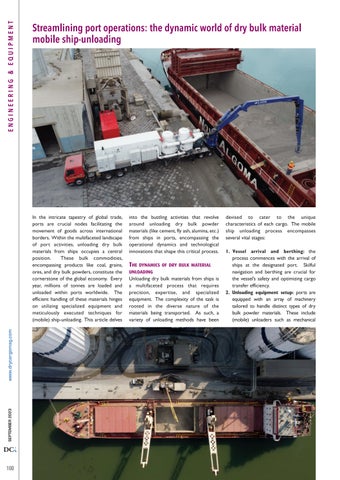ENGINEERING & EQUIPMENT
Streamlining port operations: the dynamic world of dry bulk material mobile ship-unloading
SEPTEMBER 2023
www.drycargomag.com
In the intricate tapestry of global trade, ports are crucial nodes facilitating the movement of goods across international borders. Within the multifaceted landscape of port activities, unloading dry bulk materials from ships occupies a central position. These bulk commodities, encompassing products like coal, grains, ores, and dry bulk powders, constitute the cornerstone of the global economy. Every year, millions of tonnes are loaded and unloaded within ports worldwide. The efficient handling of these materials hinges on utilizing specialized equipment and meticulously executed techniques for (mobile) ship-unloading. This article delves
DCi 100
into the bustling activities that revolve around unloading dry bulk powder materials (like cement, fly ash, alumina, etc.) from ships in ports, encompassing the operational dynamics and technological innovations that shape this critical process.
THE DYNAMICS OF DRY BULK MATERIAL UNLOADING
Unloading dry bulk materials from ships is a multifaceted process that requires precision, expertise, and specialized equipment. The complexity of the task is rooted in the diverse nature of the materials being transported. As such, a variety of unloading methods have been
devised to cater to the unique characteristics of each cargo. The mobile ship unloading process encompasses several vital stages: 1. Vessel arrival and berthing: the process commences with the arrival of ships at the designated port. Skilful navigation and berthing are crucial for the vessel’s safety and optimizing cargo transfer efficiency. 2. Unloading equipment setup: ports are equipped with an array of machinery tailored to handle distinct types of dry bulk powder materials. These include (mobile) unloaders such as mechanical
